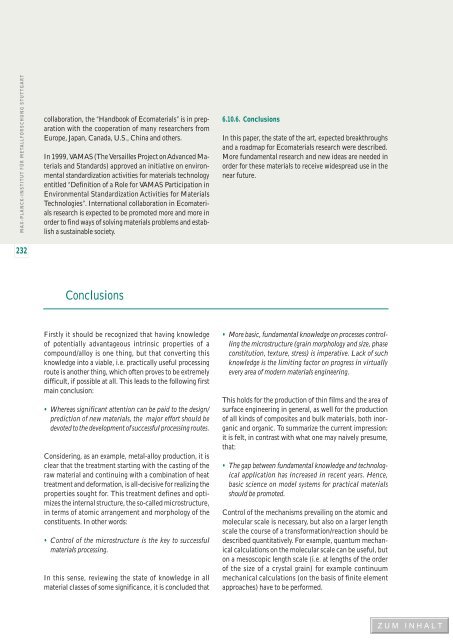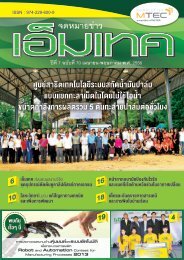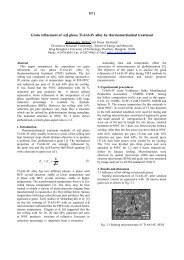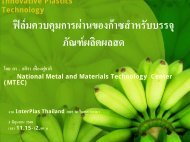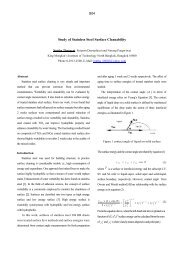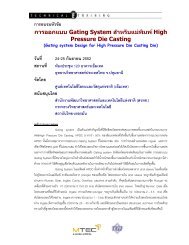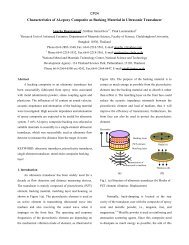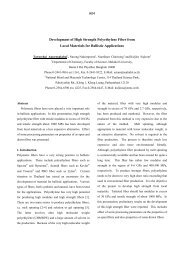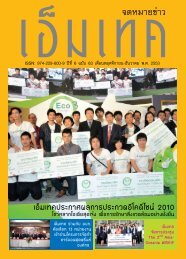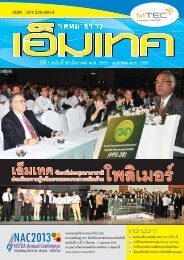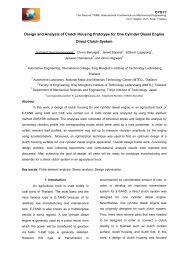- Page 1 and 2:
EUROPEAN WHITE BOOKON F UNDAMENTAL
- Page 3 and 4:
MAX-PLANCK-INSTITUT FÜR METALLFORS
- Page 5 and 6:
MAX-PLANCK-INSTITUT FÜR METALLFORS
- Page 7 and 8:
MAX-PLANCK-INSTITUT FÜR METALLFORS
- Page 9 and 10:
MAX-PLANCK-INSTITUT FÜR METALLFORS
- Page 11 and 12:
MAX-PLANCK-INSTITUT FÜR METALLFORS
- Page 13 and 14:
MAX-PLANCK-INSTITUT FÜR METALLFORS
- Page 15 and 16:
MAX-PLANCK-INSTITUT FÜR METALLFORS
- Page 17 and 18:
CHAPTER 11. MATERIALS: SCIENCEAND E
- Page 19 and 20:
1.1. Metals and Composites: Basis f
- Page 21 and 22:
FEG (FEG = field emission gun) scan
- Page 23 and 24:
interfaces typically have bottlenec
- Page 25 and 26:
IC-PackagesSubstratesDielectricsIR
- Page 27 and 28:
cused on the elaboration of new com
- Page 29 and 30:
processing techniques adequate for
- Page 31 and 32:
(soil, water, air). Fibres, whisker
- Page 33 and 34:
R & D tasksSocio-economic impact•
- Page 35 and 36:
GeosciencesBiosciences1.4. Inorgani
- Page 37 and 38:
The countries of the Central Europe
- Page 39 and 40:
sis of new molecules must be encour
- Page 41 and 42:
progress in the field of biomimetic
- Page 43 and 44:
ities, allowing the coding of hybri
- Page 45 and 46:
iii) The last decade has also been
- Page 47 and 48:
The area of synthetic polymers is u
- Page 49 and 50:
macromolecular sciences, including
- Page 51 and 52:
• Enhanced efforts in the finding
- Page 53 and 54:
1.7. Carbon MaterialsR. Schlögl |
- Page 55 and 56:
modelling and analysis of adventiti
- Page 57 and 58:
Device size100 m10 mreduction in th
- Page 59 and 60:
(d) Materials for optical communica
- Page 61 and 62:
developed as well as novel concepts
- Page 63 and 64:
As a final point in this list let u
- Page 65 and 66:
ConclusionsIn this chapter the need
- Page 67 and 68:
MAX-PLANCK-INSTITUT FÜR METALLFORS
- Page 69 and 70:
MAX-PLANCK-INSTITUT FÜR METALLFORS
- Page 71 and 72:
MAX-PLANCK-INSTITUT FÜR METALLFORS
- Page 73 and 74:
MAX-PLANCK-INSTITUT FÜR METALLFORS
- Page 75 and 76:
MAX-PLANCK-INSTITUT FÜR METALLFORS
- Page 77 and 78:
MAX-PLANCK-INSTITUT FÜR METALLFORS
- Page 79 and 80:
MAX-PLANCK-INSTITUT FÜR METALLFORS
- Page 81 and 82:
MAX-PLANCK-INSTITUT FÜR METALLFORS
- Page 83 and 84:
MAX-PLANCK-INSTITUT FÜR METALLFORS
- Page 85 and 86:
MAX-PLANCK-INSTITUT FÜR METALLFORS
- Page 87 and 88:
MAX-PLANCK-INSTITUT FÜR METALLFORS
- Page 89 and 90:
MAX-PLANCK-INSTITUT FÜR METALLFORS
- Page 91 and 92:
MAX-PLANCK-INSTITUT FÜR METALLFORS
- Page 93 and 94:
MAX-PLANCK-INSTITUT FÜR METALLFORS
- Page 95 and 96:
MAX-PLANCK-INSTITUT FÜR METALLFORS
- Page 97 and 98:
MAX-PLANCK-INSTITUT FÜR METALLFORS
- Page 99 and 100:
MAX-PLANCK-INSTITUT FÜR METALLFORS
- Page 101 and 102:
MAX-PLANCK-INSTITUT FÜR METALLFORS
- Page 103 and 104:
MAX-PLANCK-INSTITUT FÜR METALLFORS
- Page 105 and 106:
MAX-PLANCK-INSTITUT FÜR METALLFORS
- Page 107 and 108:
MAX-PLANCK-INSTITUT FÜR METALLFORS
- Page 109 and 110:
MAX-PLANCK-INSTITUT FÜR METALLFORS
- Page 111 and 112:
CHAPTER 33. INNOVATION IN MATERIALS
- Page 113 and 114:
3.1. Present State of Materials Sci
- Page 116 and 117:
MAX-PLANCK-INSTITUT FÜR METALLFORS
- Page 118 and 119:
MAX-PLANCK-INSTITUT FÜR METALLFORS
- Page 120 and 121:
MAX-PLANCK-INSTITUT FÜR METALLFORS
- Page 122 and 123:
CHAPTER 44. M ATERIALS THEORYAND MO
- Page 124 and 125:
4.1. Predictive Modelling of Materi
- Page 126 and 127:
theory); some approaches use local
- Page 128 and 129:
ists. Historically, many pioneering
- Page 130 and 131:
even clearer or simpler. Thus a sys
- Page 132 and 133:
nanostructured composites for speci
- Page 134 and 135:
million atoms on today’s supercom
- Page 136 and 137:
Ceramic TheoryQuantum physics, soli
- Page 138 and 139:
Functional CeramicsAtomistic Modell
- Page 140 and 141:
Time (s)10 2110 -210 -410 -610 -8in
- Page 142 and 143:
New strategies for modelling of com
- Page 144 and 145:
European researchers in academic an
- Page 146 and 147:
MAX-PLANCK-INSTITUT FÜR METALLFORS
- Page 148 and 149:
MAX-PLANCK-INSTITUT FÜR METALLFORS
- Page 150 and 151:
MAX-PLANCK-INSTITUT FÜR METALLFORS
- Page 152 and 153:
MAX-PLANCK-INSTITUT FÜR METALLFORS
- Page 154 and 155:
MAX-PLANCK-INSTITUT FÜR METALLFORS
- Page 156 and 157:
MAX-PLANCK-INSTITUT FÜR METALLFORS
- Page 158 and 159:
MAX-PLANCK-INSTITUT FÜR METALLFORS
- Page 160 and 161:
MAX-PLANCK-INSTITUT FÜR METALLFORS
- Page 162 and 163:
MAX-PLANCK-INSTITUT FÜR METALLFORS
- Page 164 and 165:
MAX-PLANCK-INSTITUT FÜR METALLFORS
- Page 166 and 167:
MAX-PLANCK-INSTITUT FÜR METALLFORS
- Page 168 and 169:
MAX-PLANCK-INSTITUT FÜR METALLFORS
- Page 170 and 171:
MAX-PLANCK-INSTITUT FÜR METALLFORS
- Page 172 and 173:
MAX-PLANCK-INSTITUT FÜR METALLFORS
- Page 174 and 175: MAX-PLANCK-INSTITUT FÜR METALLFORS
- Page 176 and 177: MAX-PLANCK-INSTITUT FÜR METALLFORS
- Page 178 and 179: MAX-PLANCK-INSTITUT FÜR METALLFORS
- Page 180 and 181: MAX-PLANCK-INSTITUT FÜR METALLFORS
- Page 182 and 183: MAX-PLANCK-INSTITUT FÜR METALLFORS
- Page 184 and 185: MAX-PLANCK-INSTITUT FÜR METALLFORS
- Page 186 and 187: MAX-PLANCK-INSTITUT FÜR METALLFORS
- Page 188 and 189: CHAPTER 66. MATERIALS SYNTHESISAND
- Page 190 and 191: Presently, experimental efforts are
- Page 192 and 193: Significant improvement in both, th
- Page 194 and 195: 6.2. Synthesis and Processing of In
- Page 196 and 197: Currently, the EU countries, in par
- Page 198 and 199: 6.3.2. State of the ArtIn the last
- Page 200 and 201: At present, the U.S. is likely the
- Page 202 and 203: ous Ziegler-Natta based catalysts h
- Page 204 and 205: 3. MMCs offer significant improveme
- Page 206 and 207: matrix composites, and chemical pro
- Page 208 and 209: In the liquid phase routes, the fib
- Page 210 and 211: applications. This is due to the de
- Page 212 and 213: 6.8. Electronic SystemsP.S. Peercy
- Page 214 and 215: Source: University of WisconsinSing
- Page 216 and 217: 6.8.4. ConclusionElectronic materia
- Page 218 and 219: first demonstrated in materials sys
- Page 220 and 221: length of light. Low cost fabricati
- Page 222 and 223: Type A- pollution prevention- green
- Page 226 and 227: Special emphasis today is placed on
- Page 228 and 229: MAX-PLANCK-INSTITUT FÜR METALLFORS
- Page 230 and 231: MAX-PLANCK-INSTITUT FÜR METALLFORS
- Page 232 and 233: MAX-PLANCK-INSTITUT FÜR METALLFORS
- Page 234 and 235: MAX-PLANCK-INSTITUT FÜR METALLFORS
- Page 236 and 237: MAX-PLANCK-INSTITUT FÜR METALLFORS
- Page 238 and 239: MAX-PLANCK-INSTITUT FÜR METALLFORS
- Page 240 and 241: MAX-PLANCK-INSTITUT FÜR METALLFORS
- Page 242 and 243: MAX-PLANCK-INSTITUT FÜR METALLFORS
- Page 244 and 245: MAX-PLANCK-INSTITUT FÜR METALLFORS
- Page 246 and 247: MAX-PLANCK-INSTITUT FÜR METALLFORS
- Page 248 and 249: MAX-PLANCK-INSTITUT FÜR METALLFORS
- Page 250 and 251: MAX-PLANCK-INSTITUT FÜR METALLFORS
- Page 252 and 253: MAX-PLANCK-INSTITUT FÜR METALLFORS
- Page 254 and 255: MAX-PLANCK-INSTITUT FÜR METALLFORS
- Page 256 and 257: MAX-PLANCK-INSTITUT FÜR METALLFORS
- Page 258 and 259: MAX-PLANCK-INSTITUT FÜR METALLFORS
- Page 260 and 261: CHAPTER 88. MATERIALS SCIENCEIN EUR
- Page 262 and 263: in real world applications. This ev
- Page 264 and 265: in large part to the erosion of the
- Page 266 and 267: udgetary (funding agencies, nationa
- Page 268 and 269: All these events should have a stro
- Page 270 and 271: EC Materials ResearchInfrastructure
- Page 272 and 273: Structural MaterialsNanomaterialsBi
- Page 274 and 275:
8.7. New Strategies for European Re
- Page 276 and 277:
ilities, and provide frequent oppor
- Page 278 and 279:
MPI CoalResearchMPI MetalsResearchE
- Page 280 and 281:
MAX-PLANCK-INSTITUT FÜR METALLFORS
- Page 282 and 283:
MAX-PLANCK-INSTITUT FÜR METALLFORS
- Page 284 and 285:
MAX-PLANCK-INSTITUT FÜR METALLFORS
- Page 286 and 287:
MAX-PLANCK-INSTITUT FÜR METALLFORS
- Page 288 and 289:
MAX-PLANCK-INSTITUT FÜR METALLFORS
- Page 290 and 291:
MAX-PLANCK-INSTITUT FÜR METALLFORS
- Page 292 and 293:
MAX-PLANCK-INSTITUT FÜR METALLFORS
- Page 294 and 295:
MAX-PLANCK-INSTITUT FÜR METALLFORS
- Page 296 and 297:
MAX-PLANCK-INSTITUT FÜR METALLFORS
- Page 298 and 299:
MAX-PLANCK-INSTITUT FÜR METALLFORS
- Page 300 and 301:
APPENDIX IMAX-PLANCK-INSTITUT FÜR
- Page 302 and 303:
MAX-PLANCK-INSTITUT FÜR METALLFORS
- Page 304 and 305:
MAX-PLANCK-INSTITUT FÜR METALLFORS
- Page 306 and 307:
MAX-PLANCK-INSTITUT FÜR METALLFORS
- Page 308 and 309:
APPENDIX IVMAX-PLANCK-INSTITUT FÜR
- Page 310 and 311:
MAX-PLANCK-INSTITUT FÜR METALLFORS
- Page 312 and 313:
MAX-PLANCK-INSTITUT FÜR METALLFORS
- Page 314 and 315:
MAX-PLANCK-INSTITUT FÜR METALLFORS
- Page 316:
MAX-PLANCK-INSTITUT FÜR METALLFORS


